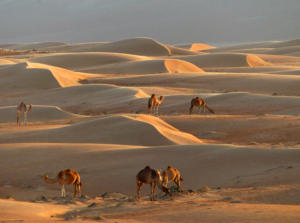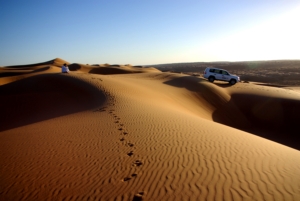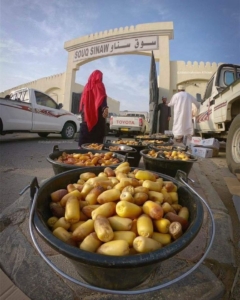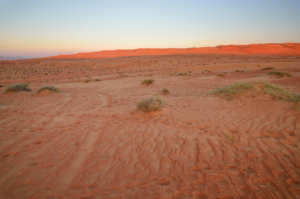
Muscat Desert Safari: A Local’s Secret Tips for First-Time Visitors
The Wahiba Sands boasts magnificent orange dunes that reach up to 200 meters high. This natural wonder stands as one of Oman’s most breathtaking attractions. The experience has left visitors spellbound, with most travelers rating it 4 stars or above.
A desert safari near Muscat goes beyond scenic views. The best time runs from November to February when you can try dune bashing, ride camels, and go sandboarding at perfect temperatures. Your Oman Muscat desert safari has authentic cultural moments inside Bedouin tents where you’ll taste traditional coffee and dates.
Let me share everything in planning your desert adventure in this piece. You’ll learn about the best spots for photos, key safety tips, and local secrets that will give you a unique experience in the Wahiba Sands.
What to Know Before Your Desert Safari
You’ll need good timing and preparation to plan a desert safari. The winter months from December to February have warm days that are perfect for activities and cool nights ideal for stargazing. The weather stays most comfortable from November through April as you learn about the big Wahiba Sands.
Best months for desert visits
The best time to take a Muscat desert safari runs from October to April. You’ll find milder weather that makes outdoor activities more fun. January and February temperatures hover around 20 degrees in Muscat with high humidity throughout the year. Stay away from Friday and Saturday since the desert gets packed with locals.
What to pack and wear
The desert’s conditions mean you’ll need specific gear and clothes. Pack light, breathable clothes for day trips and bring a warm jacket for the cold nights. From my time there, here’s your essential list:
- Cotton or linen clothes that fit loosely
- Shoes that cover your toes to protect yourself from sand
- A hat with wide brims and strong sunscreen
- A power bank and bags that keep sand out of electronics
- Basic medical supplies and any medicines you take
Women should pack a scarf to cover shoulders or hair in traditional areas. The desert gets hot in summer months, so you’ll want clothes that handle sweat well.

Booking tips from locals
Desert camps run from October to March and close down in summer because of heat and strong winds. Here’s what locals taught me about booking a Muscat desert safari:
Most tour packages come with rides from Muscat. Try to get picked up before 9:00 AM. Many people think they should rent a 4WD, but camps offer rides from nearby towns that cost less than getting your own vehicle.
If you love taking photos, book tours in the morning or late afternoon for the best light. The skies stay clearest with the least wind from November to February – perfect timing to capture amazing desert views.
Top Desert Safari Routes from Muscat
Muscat offers three distinct desert safari routes to experience Oman’s magnificent Wahiba Sands. Each route delivers its own mix of adventure and cultural immersion that ranges from quick excursions to extended stays.
Half-day safari options
Quick desert excursions from Muscat last 6-7 hours and are perfect for time-conscious travelers. These tours focus on simple desert experiences. Morning departures start around 8:30 AM, and afternoon safaris end with sunset views from towering dunes.
A half-day safari has:
- Dune bashing in 4×4 vehicles
- Visit to a traditional Bedouin house
- Camel riding opportunities
- Photography stops at golden dunes
Full-day adventures
Full-day safaris last between 8-10 hours and provide a complete desert experience. These tours combine multiple activities with visits to the most important locations. Travelers first stop at Fanja village for photos before exploring the vast desert landscape extensively.
Full-day adventures excel at mixing cultural encounters with adrenaline-pumping activities. Visitors can explore Wadi Bani Khalid’s crystal-clear pools that offer a refreshing contrast to the desert environment.

Overnight camping experiences
Overnight stays take visitors 40 kilometers deep into Wahiba Sands. These extended safaris deliver the most immersive desert experience with camps ranging from simple to luxury accommodations.
Sunset drives to the dunes’ highest points kick off evening activities. Camps buzz with traditional Omani experiences as night falls. Visitors enjoy lamb roasted over open fires and moutabal served under palm-frond roofs. Early risers can watch the sunrise paint the saffron-colored dunes in magnificent hues.
This two-day experience dedicates the first day to desert exploration. The second morning takes visitors to historical sites like Ibra’s ancient village. Travelers can fully appreciate the desert’s changing moods and colors throughout day and night with this extended format.
Desert Activities Beyond Dune Bashing
The Wahiba Sands desert is more than just thrilling dune adventures. This vast expanse holds centuries of rich Bedouin heritage waiting to be explored. The Bani Wahiba tribes, who gave the desert its name, keep their ancestral traditions alive through generations.

Traditional Bedouin experiences
A visit to a Bedouin home reveals authentic desert life. These warm-hearted hosts welcome guests with traditional hospitality and share stories that connect past and present. These encounters are a great way to get genuine knowledge about their daily routines and ancient customs.
The cultural experience has:
- Traditional handicraft making lessons
- Fresh camel milk tasting
- Traditional food preparation activities
- Ancient desert storytelling sessions
Yes, it is remarkable how Bedouin communities stay connected to their heritage despite modern influences. The sort of thing I love is seeing them use mobile phones while wearing traditional attire – a perfect balance of ancient customs and modern life.
The bustling Sinaw Market lets visitors watch Bedouin communities trade livestock and display their handicrafts. Buying these handicrafts directly supports local families and helps them maintain their traditional way of life.

Wildlife spotting opportunities
The Wahiba Sands ecosystem supports an impressive array of desert wildlife. This region is home to over 200 species of animals. Graceful gazelles, elusive desert foxes, and various reptile species roam freely.
Wildlife watching works best during early morning and late evening hours. The desert springs to life as temperatures drop, revealing its hidden inhabitants. The Sharqiyah region serves as a vital conservation area that protects many native species.
Desert safaris near Muscat let nature lovers spot the Arabian oryx, one of the region’s most magnificent creatures. The successful return of these majestic animals shows Oman’s commitment to wildlife conservation.
Photography Tips for Desert Safaris
The magic of a Muscat desert safari comes alive when you understand how light and sand work together. Desert environments create unique challenges but also amazing opportunities for photographers who want to capture their adventures.
Best times for desert photos
The original golden hours right after sunrise and before sunset create perfect lighting conditions for desert photography. Soft, angled light creates dramatic shadows on the dunes and reveals their texture and form. The harsh midday sun isn’t ideal, so it’s better to plan your shots for early morning or late afternoon when the sand glows with rich golden colors.
The night sky opens up a whole new world of astrophotography possibilities. Wahiba Sands has very little light pollution, which makes it perfect for capturing the Milky Way and star-filled skies. Clear nights show an ocean of bright stars, planets, and the magnificent Milky Way itself.

Camera settings for sand
Your equipment’s safety comes first in the desert. Here are some key camera settings and precautions that work well:
- Keep ISO low (50-100) to reduce noise in bright conditions
- Use small apertures (f/11 or higher) for maximum depth of field
- Use spot metering for backlit scenes
- Add UV filters to protect lenses from sand
- Store spare batteries and memory cards in sealed containers
RAW format gives you more options in post-processing, which helps with the desert’s high contrast scenes. Fast shutter speeds should be your priority when capturing moving subjects or wildlife.
Top photo spots
Wahiba Sands has amazing locations for unique desert photography. The dune peaks reach up to 200 meters and give you stunning views for landscape shots. You’ll find remarkable photo opportunities where dunes meet the coastline at Khaluf Desert.
Bedouin tents offer authentic scenes of desert life for cultural photography. Local hosts’ warm hospitality creates intimate moments worth capturing. Light and shadow play beautifully in these settings and add depth to your images.
The best desert photos often come from unexpected angles. Natural lines in the sand, ripple patterns, and the contrast between light and shadow make compelling images. The desert’s simple color palette encourages creative composition, especially during the soft golden hour light.
Safety and Comfort in the Desert
A great Muscat desert safari experience starts with proper preparation and safety awareness. We focused on learning about local medical facilities and emergency protocols to give you peace of mind during your desert adventure.
Health precautions
Your health strategy should start with proper medical preparation. Travelers should get international health insurance that covers medical evacuation and hospital stays. Modern medical facilities exist in Muscat’s main cities. All the same, services might be limited in remote desert areas.
These simple precautions will help you deal with heat-related concerns:
- High-SPF sunscreen (reapply throughout the day)
- Wide-brimmed hat and protective sunglasses
- Loose, breathable clothing
- Adequate water supply
- Light, easily digestible meals
Staying hydrated is vital – drink water regularly, even when you don’t feel thirsty. You should avoid physical activities during peak sun hours (10 AM to 4 PM) to prevent heat exhaustion.
Emergency preparations
Desert safety needs detailed preparation and awareness. Basic first aid supplies are a great way to get help when learning about remote areas. Your medical kit should include:
- Antiseptic wipes and band-aids
- Personal medications
- Insect repellent
- Emergency contact numbers
- Basic first aid supplies
Overnight desert stays need extra safety measures. You should choose reputable tour operators with experienced guides to substantially boost safety. These professionals know desert navigation and manage to keep well-maintained vehicles with safety features.
The emergency number in Oman (9999) connects you to police, fire, and ambulance services. Most public hospitals provide 24-hour emergency services available to foreign tourists. Save local emergency contacts and know where the nearest medical facilities are right after booking your safari.
Wildlife encounters need extra caution especially when you have evening hours. Desert creatures come out at night, so proper footwear becomes essential. Tour guides suggest staying away from vegetated areas where scorpions might live.
People with existing medical conditions should talk to their healthcare providers before the trip. Some activities like dune bashing or quad biking might need extra precautions or might not suit everyone.
Note that desert temperatures change dramatically between day and night. Pack clothes for both conditions and keep emergency supplies in your vehicle. Your guide’s instructions are vital – never venture into remote areas alone.
Conclusion
Desert safaris near Muscat pack adventures that surpass typical tourist experiences. My extensive exploration of Wahiba Sands showed me how these trips combine thrilling activities with rich cultural encounters. Quick half-day tours and overnight stays both give you unique chances to experience Oman’s desert wonders.
Your desert adventure’s success depends on timing and preparation. The best time runs from November to February when temperatures stay comfortable and wildlife spotting opportunities peak. The desert might seem daunting initially, but simple safety guidelines and the right gear make your experience safe and enjoyable.
Wahiba Sands preserves centuries of Bedouin heritage waiting to be explored. Local communities’ welcome guests with traditional hospitality and share their customs and way of life. Stunning landscapes and wildlife encounters blend with this cultural richness to create memories that stay with you long after returning home.
A thoughtful plan for your desert safari should account for seasonal changes and personal interests. These local tips and safety guidelines will prepare you to experience one of Oman’s most spectacular natural wonders. You’ll capture amazing photos and embrace authentic desert culture along the way. Book Now!
